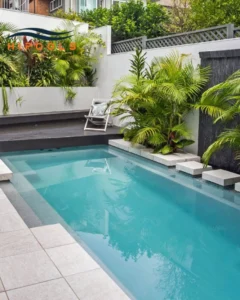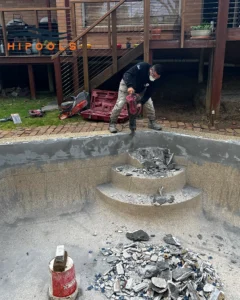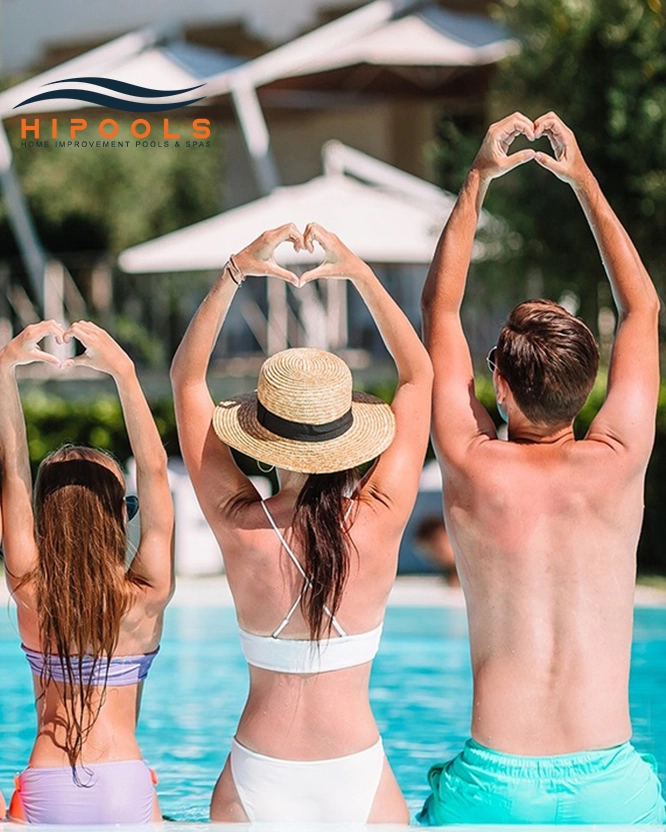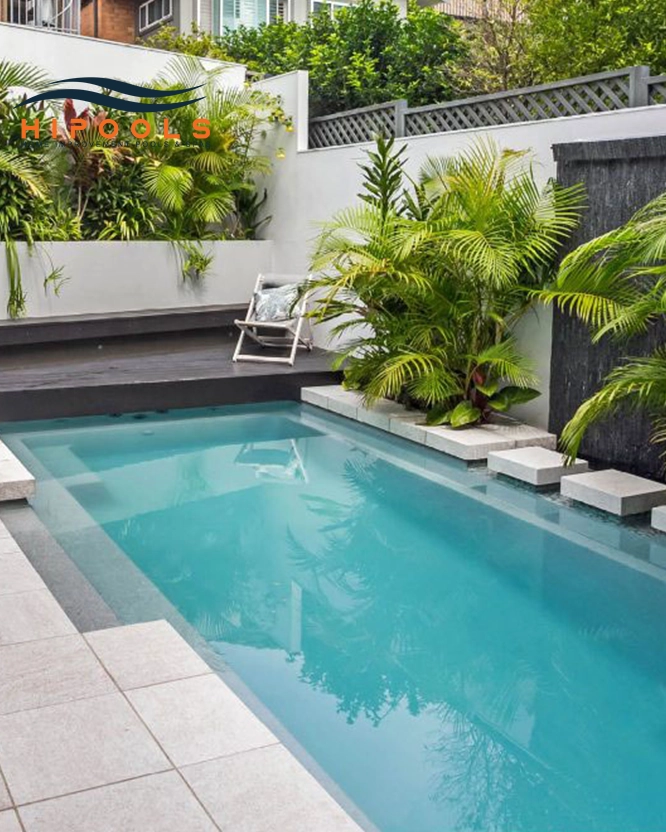Did you know an average pool can consume 15%+ of a home’s energy? Energy saving solutions for pool construction convert this drain into savvy savings. Replace outdated systems with solar pool heaters (reducing heating costs by 70%) and variable speed pumps (consumption 80% lower). Implement green designs like dark bottom finishes that absorb heat or LED lighting that minimizes electricity usage. Even pool covers reduce evaporation, saving 50% on water and chemicals.
This blog reveals how sustainable materials, smart tech automation, and green certifications turn luxury waste free. Build a pool that’s efficient by design and enjoy more swims, smaller bills, and a lighter environmental impact. Get in!
Best Energy Saving Pool Equipment to Reduce Smaller Utility Bills
Building an energy efficient pool starts with choosing the right equipment. Modern advancements in pool design can drastically reduce energy consumption without sacrificing performance. Some of the most efficient energy-saving options for your pool include:
- Variable-Speed Pumps : In contrast to single-speed pumps, variable-speed ones adjust their flow rate according to demand, trimming energy use by up to 80%. They’re quieter, last longer, and cut plenty of money on electricity.
- Solar Pool Heaters : Harnessing the sun’s free energy, solar heaters extend your swimming season without costly gas or electric bills. They’re eco-friendly and cost effective in sunny climates.
- LED Pool Lighting : LEDs consume as much as 80% less energy than traditional incandescent lights and last years longer. They also offer programmable color for a stunning night-time display.
- Smart Pool Technology : Automation systems consolidate filtration, heating, and cleaning cycles to remove wasteful energy consumption. Many can be controlled from a smartphone for convenience.
- High Efficiency Filters : Cartridge and diatomaceous earth (DE) filters require less frequent backwashing, saving both water and energy compared to standard sand filters.

2. Solar Pool Heating: How to Harness Renewable Energy for Your Pool
If you want an eco-friendly and cost-effective way to heat your pool, solar pool heating is a leading option. With the sun’s free energy, you can have a longer swim season without the expense of expensive gas or electric heaters. Let’s explore how solar heating works and why it’s a shrewd investment for pool owners.
How Solar Pool Heating Works
Solar pool heaters use solar collectors (panels) on your roof or on ground mounts close by. Your pool water is pumped through the panels, which warm it up from the sun before returning it to the pool, hotter than it left.
Solar systems never burn fossil fuels like traditional heaters only sunshine.
Key Benefits of Solar Pool Heating
Lower Running Expenses : There are minimal running expenses once installed since sunbeams are nature’s gift and cost nothing.
Environmentally Friendly : Less carbon footprint compared to gas or electric heaters.
Longer Swimming Season : Maintains the water warm even during cold months.
Long Life : Solar panels made of high quality material have a lifespan of 15, 20 years with minimal maintenance.
Solar vs. Heat Pumps vs Gas Heaters
- Solar Heaters Best for sunny climatic conditions; low operation cost but dependent on sunshine.
- Heat Pumps Effective like gas but still electricity based; best for cloudy regions.
- Gas Heaters Rapid heating but high operation cost, higher carbon footprint.
Long-Term Savings & ROI
While solar pool heating has a higher upfront cost ($3,000, $7,000), it pays for itself in 3, 7 years through energy savings. Many homeowners also qualify for tax credits or rebates, improving affordability.
By choosing solar, you’ll enjoy a warm pool while cutting energy bills and supporting sustainability.
Why Variable-Speed Pumps Are a Game Changer for Energy Savings
And if you’d like to trim your pool’s power bills, one of the best things you can do is install a variable speed pump. Unlike outdated single-speed pumps, these new-fangled gadgets adjust their motor speed to accommodate your pool’s needs, and in doing so, conserve staggering amounts of energy.
How Variable-Speed Pumps Save Energy
- Variable Flow Rates : Low speeds for filtration (energy saving) and high speeds as needed (…, for cleaning).
- Energy Savings up to 80% : Unlike single-speed pumps, which are constantly running at full power.
- Less Noise & Longer Life : Reduced wear and tear equals longer life for the pump.
Comparative Costs: Variable Speed vs Single Speed Pumps
| Feature | Single Speed Pump | Variable Speed Pump |
|---|---|---|
| Energy Use | High (operates at full power continuously) | Low (adjusts speed accordingly) |
| Level of Noise | Noisy | Much less noisy |
| Life Span | 5,7 years | 10+ years |
| Annual Cost | $500, $800 | $100, $200 |

Return on Investment (ROI)
Even though variable speed pumps are higher in the beginning ($600, $1,500), they pay back their cost in 1, 3 years in terms of energy savings. There is usually a rebate for the upgrade provided by most utility companies.
Best Practices for Efficiency
- Run the pump at lower speeds for longer periods (better filtration with less energy).
- Use a timer or smart controller to optimize run times.
By switching to a variable-speed pump, you’ll cut energy bills, reduce noise, and enjoy a more efficient pool system.
Green Pool Design: Shape, Depth, and Landscaping Tricks
Green pool design goes far beyond appliances it starts with meticulous planning of shape, depth, and landscaping in order to maximize energy efficiency. By optimizing natural heating, cooling, and water conservation, you can have that gorgeous pool without draining the environment or your finances.
Pool Shape & Orientation
- Freeform or Rectangular? A rectangular pool is easier to cover (less heat loss), yet freeform pools blend more naturally into the landscape.
- Sun Exposure : Position the pool for full southern exposure (in the North). This gives natural solar heating.
- Wind Protection : Shield against wind, which cools water and speeds evaporation, with fencing, shrubs, or walls.
Ideal Depth for Efficiency
- Shallow Spots Heat Up Quick : Steadily sloping or sun shelf assist in soaking up more solar heat.
- Deep Areas Remain Cooler : Balance depth to reduce heating needs in warmer climates.
Energy-Efficient Landscaping
- Deciduous Trees : Provide summer shade (cooling the pool) but allow winter sunlight.
- Native Plants : Conserve water and chemical runoff.
- Permeable Surfaces : Use pavers or gravel on the pool deck to prevent heat absorption and provide drainage.
By incorporating these design elements, your pool will be comfortable without excessive energy expenditure.

Insulating Your Pool: Avoid Heat Loss and Save Energy
Evaporation and uninsulated surfaces account for 70% of a pool’s heat loss. Insulation is a cost effective way to retain heat, lower your heating bills, and extend your swim season.
Best Pool Insulation Methods
- Thermal Pool Covers
- Reduce heat loss by 50, 70% and cut evaporation .
- Automatic covers are easy, while solar blankets are budget friendly.
2. Insulated Pool Walls & Floor
- Spray foam or rigid foam boards installed beneath the pool shell increase heat retention.
- Ideal for new construction or renovation.
3. Insulated Plumbing
- Encasing pipes with foam insulation prevents loss of heat as water passes through.
- Necessary in cold weather to avoid freezing.
Cost vs Savings
| Method | Upfront Cost | Annual Savings |
|---|---|---|
| Thermal Cover | $100, $1,500 | $200, $500 |
| Wall Insulation | $500, $3,000 | 10, 20% heating reduction |
| Pipe Insulation | $50, $200 | Prevents heat loss in circulation |
An insulated pool will save heating bills by 30, 50%, and it is a worthwhile long-term investment.
LED Pool Lighting: Light Up Your Backyard Efficiently
Replacing LED pool lights is an easy win when it comes to energy-conserving steps while making your pool more attractive. LEDs last longer than older incandescent bulbs, use much less power, and are available in gorgeous colors.
Why Use LED Pool Lighting?
80% Less Energy Consumption : 50W LED is the same as a 300W incandescent.
Longer Life :30,000, 50,000 hours vs. 5,000 for halogen.
Bright Colors & Effects : LED usually includes RGB color-changing functionality.
Comparison: LED vs Halogen Lights
| Feature | Halogen | LED |
|---|---|---|
| Wattage | 300, 500W | 30, 100W |
| Lifespan | 3,000, 5,000 hrs | 30,000, 50,000 hrs |
| Cost/Year | $150+ | $20–$50 |
Installation Tips
- Use low voltage 12V LEDs for safety.
- Select smart LED systems that sync with apps for customized light schedules.
Smart Pool Technology: Automate Energy Savings
One of the easiest methods to cut energy costs while gaining convenience is to make the switch to smart pool technology. These new pools do all the work for you, automating pool maintenance, conserving energy, and even alerting you if a problem is brewing all from your phone.
Key Smart Pool Features for Energy Efficiency
- Wi-Fi Pool Controllers : Remotely make adjustments to pumps, heaters, and lights to prevent excessive water running time.
- Automated Timers : Schedule filtration during off peak energy times to save on lower rates.
- Leak Detectors : Prevent unnecessary water and heat loss by alerting you to real-time leaks.
- Weather Adaptive Modes : Intelligent systems adjust heating and filtration according to temperature and usage profiles.
Best Smart Pool Solutions
- Pentair Intelli Connect : Monitors equipment and provides energy consumption reports.
- Hayward OmniLogic : Alexa/Google Home voice control compatibility.
- iAquaLink : Remote access anywhere with an app.
Energy Savings & Return on Investment
- Reduced pump runtime of up to 50% through schedules optimized.
- Scales down heating costs by adjusting temps based on weather forecasts.
- Pays for itself in 1, 3 years through reduced utility bills.
Click here for more information about How Does Temperature Affect Solar Panel Energy Production?
Get your pool smart today! Order a free quote from HiPools in Georgia to automate your energy savings!
Eco Friendly Materials for Green Pool Construction
Building a pool with eco-friendly materials is earth-friendly but offers a long-term, gorgeous backyard oasis. From recycled glass to non-toxic paint, green choices matter.
Best Green Pool Materials
- ♻ Recycled Glass Tiles Made from post-consumer glass, the tiles reflect without mining fresh materials.
- Natural Stone Decking The locally harvested stone (like travertine) lasts decades and is cooler than concrete.
- Fiberglass Shells Patterns molded in advance reduce building waste over concrete.
Benefits of Eco Friendly Pool Building
✔ Less Chemical Use Natural materials do not promote algae growth.
✔ Less Heat Gain Light colors and stone keep the water cooler.
✔ Longer Lifespan Eco materials are more durable than conventional ones.

The Power of Pool Covers: Reduce Evaporation and Heating Bills
A good pool cover is one of the most effective methods of saving energy and water. Evaporation, responsible for 70% of heat loss, can be reduced to zero through it, reducing heating bills by 50–70%.
Pool Cover Comparisons
| Type | Best For | Energy Savings |
|---|---|---|
| Solar Blankets | Budget warmth | 50% heat retention |
| Thermal Covers | Heavy insulation | 60, 70% less heat loss |
| Automatic Safety Covers | Convenience + child safety | 70%+ savings |
Why Use a Pool Cover?
- Saves 5,000–10,000 gallons of water per year by reducing evaporation.
- Reduces chemical usage by preventing contamination of debris.
- Lengthens swimming season by holding heat at night.
Construct an Energy Saving Pool & Save in the Long Run
Constructing an energy-saving pool isn’t just eco-friendly it is financially practical. From solar heating and variable-speed pumps to smart automation and green materials, every upgrade is cost-saving yet enhances performance. Minor add-ons like pool covers and LED lighting make a big difference, while best insulation and green design yield the highest efficiency.
By implementing these strategies, you’ll enjoy a lower maintenance, cost effective pool that’s kinder to the environment. Ready to start saving? Contact HiPools in Georgia today for a free estimate on energy efficient pool construction or upgrades.
Dive into a smarter, greener pool without sacrificing luxury or comfort!


No comment